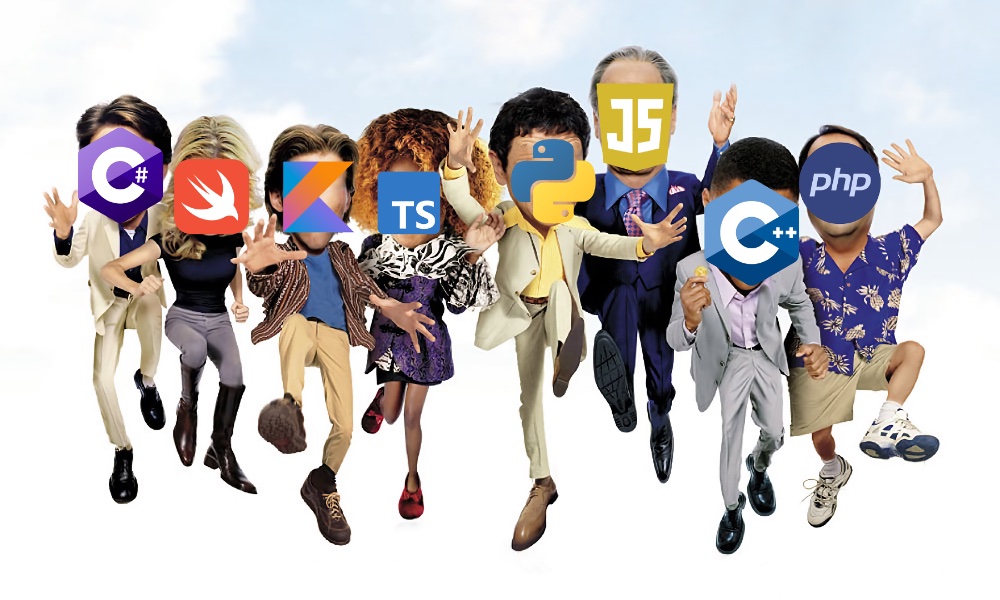
The situation with YAP is very similar to the events of this film. Did you find out from which one?
Ratings are subjective
To begin with, the popularity of programming languages is a very subjective concept. There is simply not enough data for an objective analysis. It is simply impossible to track even the approximate number of programmers who started learning a particular language, or individual projects in which it is used.
Basically, to calculate the popularity of YP, they use the search results of large search engines. But even with the same initial data, analytic results sometimes differ dramatically.
TIOBE Index
The TIOBE Index is one of the most famous rankings of programming languages. The analysis uses search engine queries that include the name of the language. For example, "python for beginners". But already here there are several nuances that could potentially affect the place of the nuclear industry in the ranking.
The rating does not take into account the quality and quantity of the written code in a particular language. In fact, indirect data is used for analysis.
TIOBE does not include Yandex search. That is, at least half of the requests from Russian-speaking countries go down the drain. Also, the Chinese search engine Baidu is not counted. Nevertheless, the rating remains one of the most popular.
Now directly about programming languages.
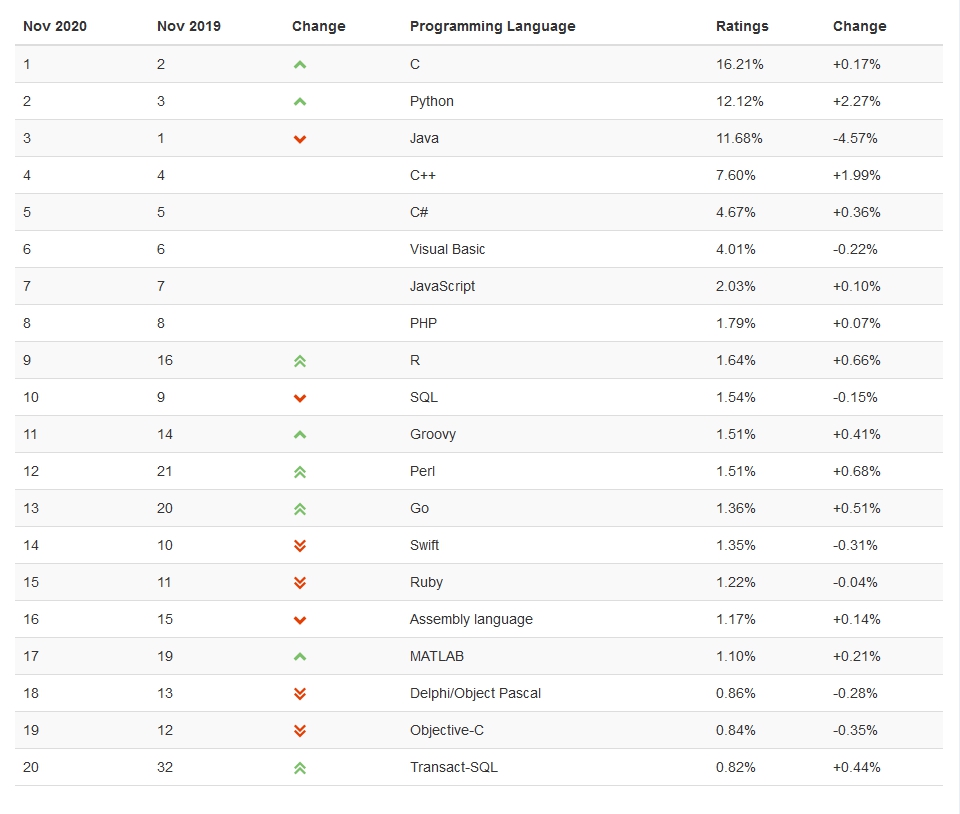
In the first place was S. Since the beginning of the year, it has consistently occupied approximately 16% of the market.
Java, which was the leader back in January, is rapidly collapsing. He lost a third of points and dropped to third place. Experts believe that the fall of Java and the rise of Python, which has risen to second place, is a consequence of the pandemic.
The popularity of Python is also fueling significant growth in the Data Science industry, where Python is considered the language of choice. To the disappointment of R fans, Python is demanding 81% of vacancies for big data analysts (read more about this in our blog post ), and R (without Python) is needed only 3% of the time.
However, the active change in the ranking in 2020 could be caused by the May changes in Google algorithms. After all, it was in May that the sharp drop in the Java rating and the rise in Python began.
The low position of JavaScript seems a little strange. 2% of the rating, and 7th place is too low a result, in our opinion. Indeed, in terms of the number of pull requests to GitHub, JavaScript is confidently leading . More than 20% of all pull requests are JavaScript. By comparison, Python is in second place at 15.9%.
The activity of the developer community speaks much more than the number of keywords in the search results. And despite JavaScript's strong position on GitHub, TIOBE's JavaScript has never risen above the 6th position in its history.
For example, here is a comparison of JavaScript and C ratings even without taking C ++ into account:
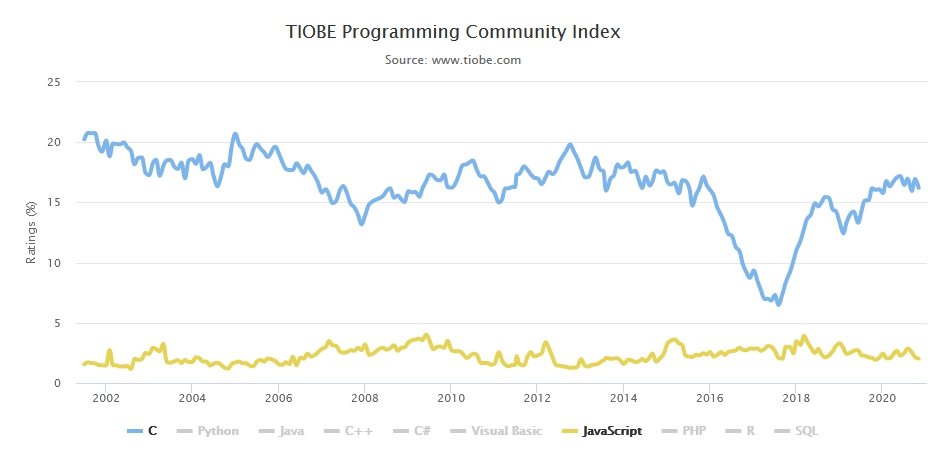
According to the TIOBE rating, C has every chance of becoming the language of 2020. If no major changes happen in December, then this title will be for the language for the second year in a row - only Objective-C could boast of such a title earlier.
PYPL - rating from GitHub
PYPL is another rating for the popularity of programming languages. And he uses a completely different analysis system.
TIOBE takes into account the total number of pages that are specific to a particular language. Actually, this is one of the reasons why C is consistently among the leaders, because many popular programming languages appeared much later.
The PYPL ranking uses Google trends for analysis. They are used to evaluate how often users search for tutorials in a particular language. Indeed, according to the creators of the rating, it is the search for tutorials that shows how popular the language is now.

PYPL shows amazing stability. The top ten positions have not changed at all over the past year. But they account for 85.94% of all requests.
Python is confidently leading, its index is almost 2 times higher than that of Java, with its second place. At the same time, the gap between the second and third place is also almost 2 times. So together Python and Java account for almost half of all tutorial requests. This means that they are the ones that are most actively studied in 2020.
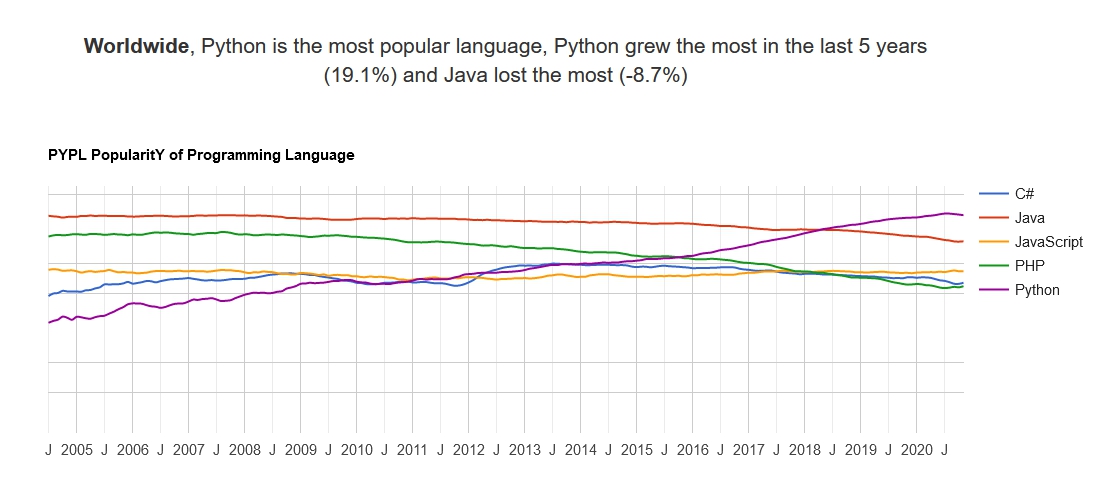
— Python ( Java). ? ?
Python , . , . , , . IT- . Python - , , .
Here we come to another reason. Python allows you to write a working prototype of a script using a few dozen lines of code, unlike other languages, which will already have a hundred or two. This makes Python development much faster. And for many companies, you need to be the first in order not to get lost in the market.
Semyon Berezovsky, mentor of the SkillFactory course "Python for Web Development"
Among other programming languages, active growth is demonstrated by Go, Rust, Ada, Lua and Dart. They can be viewed as promising languages, but so far the interest in them is too small to be reckoned with on a global scale. Only Go crossed the 1% mark.
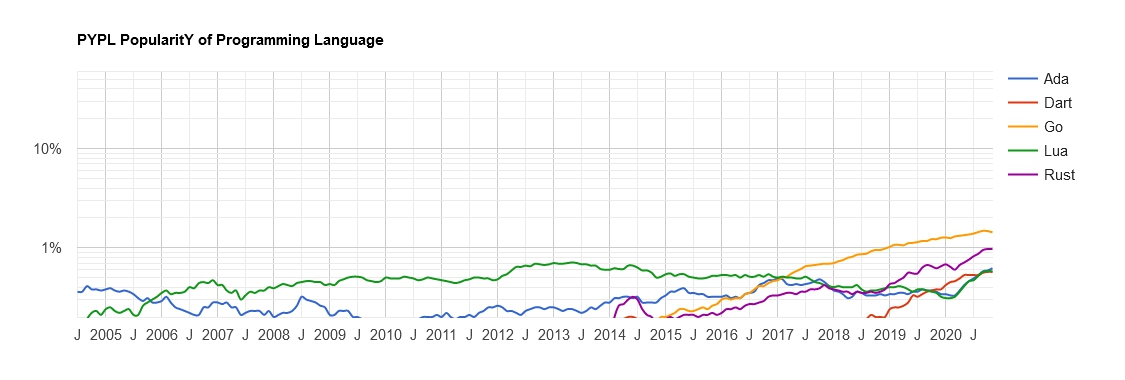
To summarize, the PYPL rating gives a good understanding of which programming languages are currently being actively studied or are looking for solutions to specific problems for them.
But at the same time, it does not show what languages programmers work in. After all, to complete work tasks it is not at all necessary to search for tutorials on the Internet.
Survey of programmers in the post-Soviet space
At the beginning of 2020, DOU published the results of a survey of nearly 10,000 programmers from post-Soviet countries. And on the basis of their answers, a rating of the languages in which they write the most was compiled.
Yes, a sample of 10,000 questionnaires is small compared to the analysis of millions of search engine queries. But at the same time, it provides a more complete vision of the true popularity of languages. After all, not indirect data are used, but quite direct ones.
First of all, we are interested in the question "What language do you write in now?" After all, it is he who shows how common the language is in the work sphere, and not in the vastness of the theory or the popularity of teaching.
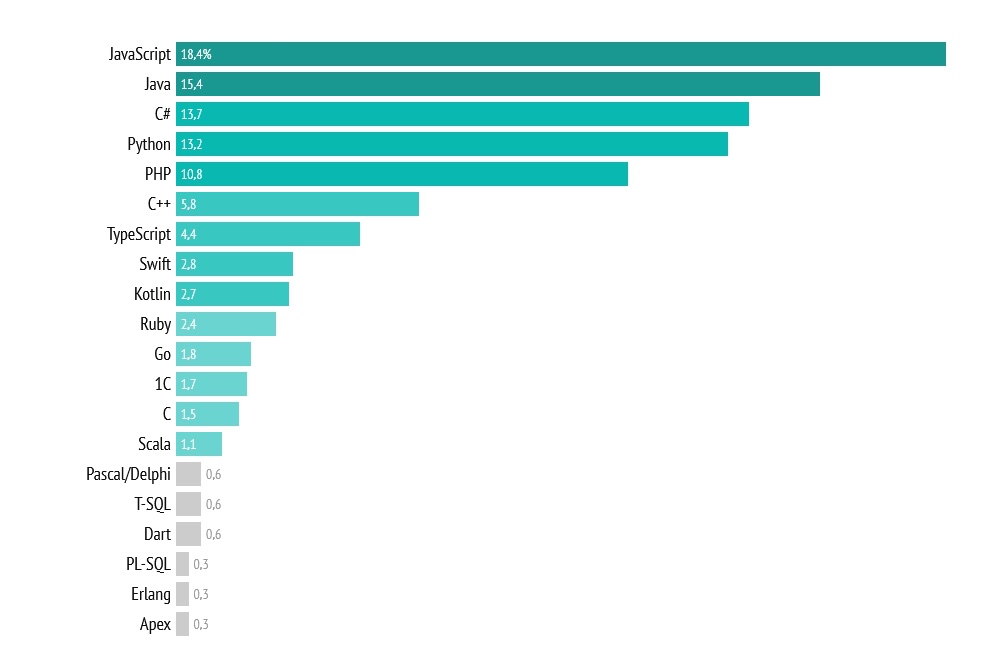
The top five repeat the PYPL rating with minor changes. Unless there is such a huge gap between Python and other programming languages. And the spread of first place from 18.4% and fifth from 10.8% cannot be considered too large.
At the same time, the first five positions cover 71.5% of the market, which also correlates with the PYPL rating. But there are also changes here. Compared to 2019, JavaScript and Python are growing, but the ratings for Java, C # and PHP are gradually falling.
Python is growing especially actively. The number of developers who consider Python as their main language grew by 21.1% compared to 2019.
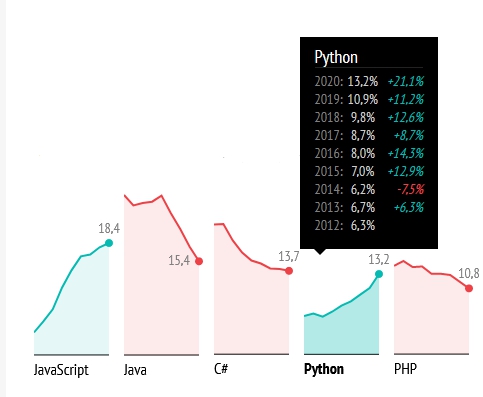
Python . . . .
, Python . 5 %.
At the same time, TypeScript is growing very actively, which in general makes sense. After all, the development of mobile software in TypeScript has grown exponentially over the past few years. Therefore, programmers who plan to develop software for smartphones should pay attention to this YaP. Well, for those who already know JavaScript, Bill Gates himself ordered.
Conclusion
If we summarize the information from all the ratings, the following picture emerges.
Python, JavaScript, Java and C # and PHP are the elite. They are actively studied, they are used for programming, writing and reading tutorials. The community of languages is alive, they are developing and flourishing. You can advise any of these languages for a beginner who wants to "enter IT" - and you won't be mistaken. They are really in demand and popular.
As for C / C ++, there is just a huge amount of information on them on the Internet. Despite their age, they are still strong, although they are gradually losing their audience.
As for promising programming languages that may well "shoot" in the future, then TypeScript, Kotlin, Rust and Dart are worth mentioning. They are worth paying attention to if you are looking for a promising second programming language.
But in general, it is worth remembering that any ratings of such a plan are subjective and largely depend on how the data is analyzed. So if you want to learn C ++ - go ahead. And even if Whitespace is interesting (pah-pah-pah), then it is possible. Good luck in your endeavors! For those who decide to learn a language, we are always ready to help with this. And the promo code HABR will add 10% to the discount on the banner.

- Python for Web Development Course
- JavaScript course
- Java developer profession
- The profession of iOS developer from scratch
- Android-
- C++
- -
E
- Data Scientist
- Data Analyst
- «Machine Learning Pro + Deep Learning»
- Machine Learning
- « Machine Learning Data Science»
- Unity
- DevOps